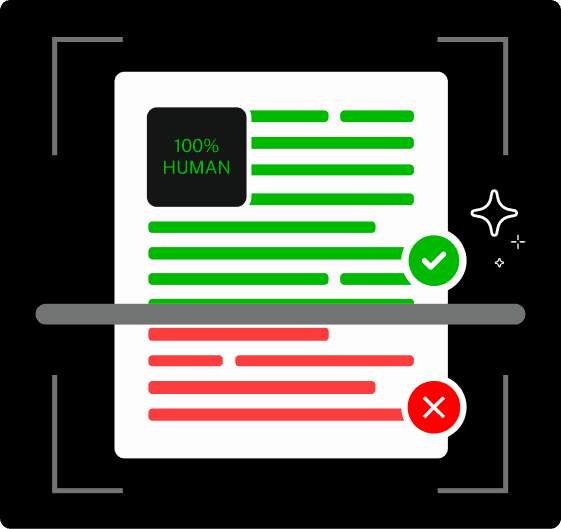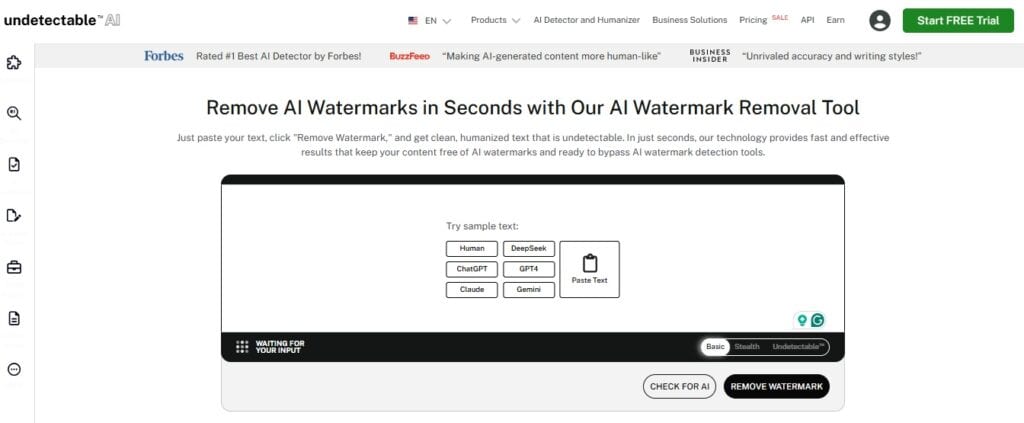Every AI detection tool you come across today will likely boast a bold claim of being > 95% accurate. Some even say that they are 100% reliable!
But are AI detectors accurate? Really?
AI models are constantly being updated. The current version of ChatGPT, for example, is a lot more nuanced and context-aware than the version we saw in 2022.
So, it’s pretty natural that many AI detectors will struggle to accurately label its text as AI-generated.
That said, some tools undeniably perform better than others. But to figure out which ones actually live up to their claims, you need to test them.
That’s exactly what we did in this article.
We evaluated 10 of the most popular AI detectors on the same benchmark used by ZDNet to see how accurate are AI detectors.
Here’s what we found!
Key Takeaways
- AI detectors analyze word frequency, sentence variation, and syntax to determine whether text was written by a human or generated by AI.
- The AI detection of many tools is not 100% foolproof because a lot of human and AI writing shares the same grammatical structures, which leads to false positives and negatives.
- The three main techniques to accurately detect AI content are statistical language modeling, metadata and watermarking, and machine learning classifiers
- Undetectable AI combines multiple detection algorithms into one federated system. It offers free and reliable AI detection without the common trade-offs of paid tools.

What Are AI Detectors and How Do They Work?
AI detectors are tools that determine if a piece of text was written by a human or generated by artificial intelligence.
The system breaks down text into measurable features and then scans for patterns that reveal machine authorship.
AI-generated text tends to follow statistical patterns. Language models are trained to predict the next word in a sequence, so their writing is built on probabilities that create subtle traces.


Never Worry About AI Detecting Your Texts Again. Undetectable AI Can Help You:
- Make your AI assisted writing appear human-like.
- Bypass all major AI detection tools with just one click.
- Use AI safely and confidently in school and work.
AI detectors pick up on these traces through the analysis of frequency of words, variety in sentence structure, syntax complexity, and the overall randomness (or lack of it) in phrasing.
The two most important metrics used by AI detectors are:
- Perplexity: It is a measure of how “surprised” a model is by the next word in a sentence. Human writing usually shows higher perplexity because people deviate from patterns, use idioms, insert emotion, etc, unlike AI-generated writing.
- Burstiness: It measures the variation in sentence length and rhythm. Humans naturally write with bursts of short, long, and uneven sentences, whereas AI-written content is consistent in length.
Why AI Detection Is So Difficult
Despite the differences between human and AI writing, detecting AI-generated text is a little difficult, particularly when it has been edited.
Here are some reasons why.
The Similarity Between Human and AI Writing
Writing at its core, both human and AI-written, uses the same language system of grammar, tenses, syntax, and phrasing.
AI models don’t invent language from scratch.
They simply learn from what humans have already written in the years preceding their development.
The datasets they are trained on are inherently human-written.
So, any well-developed AI-generation tool will internalize human patterns of expression and try to reproduce them.
The more data they consume, the more “human-like” their writing becomes.
False Positives and False Negatives
AI detectors are not infallible.
A false positive occurs when a human-written text is incorrectly flagged as AI-generated.
In contrast, a false negative happens when AI-written text slips through undetected.
Both of these mislabels are quite common.
Since many AI detectors rely on statistical probability rather than factual certainty, their accuracy remains limited.
Constant Model Evolution
AI detection is a moving target. Each new generation of language models becomes harder to detect.
When ChatGPT was first introduced for public use in 2022, its responses were repetitive, often formulaic.
Any AI detector today would very easily catch that kind of text as AI-written.
However, the latest GPT-5 model produces context-aware and emotionally intelligent text.
Since the quality of outputs keeps improving, detecting a more stylistically diverse AI text is a challenge.
How Accurate Are AI Detectors Today?
The honest answer to this question is that it is heavily dependent on which detector and which detection method you test.
Some AI detection tools claim near-perfect results in controlled settings, but when exposed to real-world data, their performance gets messy.
The benchmark ZDNet study evaluated 11 AI detectors against five text samples (three generated by ChatGPT, two by humans).
Any tool that marked a sample with > 70% AI-likelihood was considered to have “made a call.”
The study found that Undetectable AI was one of the few tools that achieved 100% accuracy, i.e., it correctly flagged all five samples (both human and AI) without error.
But are AI content detectors accurate for everyday users in real-life settings, too?
The thing is, real-world texts are rarely “pure AI” or “pure human.”
A lot of it is edited, paraphrased content with intentional noise, and with such adversarial conditions, the accuracy of many detectors drops sharply.
A peer-reviewed study on Copyleaks, TurnItIn, and Originality found that while they “have high accuracy” on GPT-3.5 and human content, they struggle to distinguish between GPT-4–level output.
Top 10 AI Detectors Comparison
Now, to find out what are the most accurate AI detectors, we put several tools to test using ZDNet’s evaluation method, i.e., using five text samples in total: three written by ChatGPT and two by humans.
Here’s one ChatGPT sample and one human-written sample that we used.
ChatGPT Text:

Human Written Text:

Undetectable AI
The first tool we tested was Undetectable AI, and it passed every single test.
All five text samples were correctly identified as either 100% human-written or AI-written.

The platform even showed indicators where other detectors may have raised flags.
The system uses multiple detector algorithms modeled after many different AI models (ChatGPT, Gemini, Claude, Llama, and others) but instead of relying directly on those models, they built their own federated and consensus-based system.

Essentially, each algorithm is trained on patterns from those detectors but runs independently to produce a collective judgment.
Undetectable AI also claims to “humanize” AI-generated text so that it bypasses detection, and from our results, that claim held up impressively well.
GPTZero
Next, we tested GPTZero, which also met our benchmark for accuracy and scored above the 80% threshold across all five samples.

It correctly identified both human-written pieces and two of the AI-generated texts with 100% confidence.

The only exception was one AI-generated sample, which GPTZero labeled as 71% AI-generated, but that still falls within the accurate range by our criteria.
Copyleaks
Copyleaks delivered mixed results in our testing. It stumbled right out of the gate by misclassifying the first human-written sample as 100% AI-generated.
It even flagged nine so-called “AI overused phrases.”

However, every subsequent test was accurate, i.e., it identified each text in the remaining four samples for what it was.

That inconsistency points to Copyleaks can occasionally swing to extremes, as it did with our human-written sample.
Still, when viewed across all tests, it averaged around 80% accuracy.
Quillbot
QuillBot was another standout tool in our testing, right behind Undetectable AI. It was the second tool to identify every human-written and AI-generated piece with 100% accuracy.

What’s notable is that QuillBot was originally known for its paraphrasing capabilities.
But its AI detector is also a refined analysis tool capable of pinpointing linguistic consistency gives away AI authorship.

Also worth noting is that Quillbot was not very accurate in the initial days of its launch, but it has definitely improved over the years. Currently, it is one of the few reliable AI detectors you’ll find.
ZeroGPT
ZeroGPT’s test results also showed good consistency.
The first human-written sample was labeled as 0% AI-generated, and the second came in at 9.44% AI-generated, both comfortably within the acceptable range for genuine human writing.

All three AI-generated samples, on the other hand, were correctly identified as 100% AI-written.

So, our round of testing also adds ZeroGPT to the list of reliable AI detectors.
Grammarly
Grammarly is a household name when it comes to helping writers produce grammatically accurate content, but the same can’t be said for its AI detection capabilities.
In our testing, Grammarly’s detector showed mixed and somewhat inconsistent results.
For the AI-generated samples, it flagged them as 92%, 81%, and 54% AI-generated, meaning it correctly identified two but failed one test by underestimating the AI likelihood.

On the human-written texts, it got one right and misclassified the other as AI.

So, you could say it was 60% accurate in our analysis.
Originality.ai
Originality.ai was also among very reliable AI detectors as it correctly scanned both the AI-generated and the human-written ones and gave out 100% confident results.

Originality.ai is a dedicated AI and plagiarism detection platform. It analyzes writing at a granular level and has been tested independently to catch paraphrased and edited content as well.

The only catch with Originality.ai is that it’s not completely free.
The platform offers 12,000 characters for new users, after which additional scans operate on a credit-based system.
The AI detector is priced at 2,000 credits (1 credit equals 100 words) for $14.95 per month.
Writer.com
Writer.com didn’t quite live up to expectations for AI detection, even though it has quite a name for producing AI-generated text.
Out of five text samples, it incorrectly identified 2 AI-written samples as human-written.
That means only three of the five test results were accurate, which is a clear miss.

Writer.com has also announced that its AI detection tool, along with its API endpoint, will sunset on December 22.
Until then, it will continue functioning as usual. This shows that the company is moving away from AI detection space.

Monica
This was another of those tools that performed really well upon testing.
Monica correctly identified every human-written and AI-generated sample without a single error, so you can safely add it to your list of reliable AI detectors.

The company claims that it combines the AI analytical strengths of ZeroGPT, GPTZero, and Copyleaks into one unified tool.
The system is similar to Undetectable AI, which also combines multiple detectors for authentic AI detection.

Sapling AI Detector
Sapling doesn’t turn out to be a reliable AI detector, as it was inaccurate in identifying all five text samples.
Out of our samples, Sapling identified 2 of human-written content as 100% AI, which is way off the mark.

But what stands out most about Sapling is its transparency. The company openly acknowledges that its AI detector can produce false positives with short text.
It also states that they’re actively working to improve the system to reduce such errors.

They also clarify that no current AI detector, including Sapling’s, should be used as a standalone method to determine authorship.
Use the AI Checker to analyze how reliable other AI detectors actually are.
By testing sample text through multiple detection tools and comparing consistency scores, AI Checker helps reveal which systems mislabel or overflag content.
It’s a quick, transparent way to measure detector accuracy before trusting their results.
Common AI Detection Methods Explained
AI detection isn’t built on one universal formula.
Several methods have been used and validated in determining whether a piece of text is human-written or AI-written.
Statistical Language Modeling
This is the oldest and most widely used method for AI content detection. It is based on the analysis of the probability of word sequences, i.e., how likely one word is to follow another.
AI-generated text tends to have lower “perplexity,” so you could say it is more predictable and consistent in structure.
Humans, on the other hand, introduce variability in text.
Content detectors using this method calculate perplexity and burstiness to assess their origin.
Metadata and Watermarking
These metrics target how the text was generated instead of its structure.
Watermarking means embedding invisible signals within AI output at the token level. Essentially, these patterns can only be detected by specific algorithms.
Metadata detection inspects contextual data like timestamps, generation speed, and API call patterns to infer whether AI was involved in the writing process.
But again, when AI-generated text is edited, these signals are lost, and therefore, they only work in controlled testing environments.
When AI-generated text carries invisible watermarks, tools like Undetectable AI’s AI Text Watermark Remover can help clear those hidden patterns.

It detects and removes token-level imprints, restoring the text’s natural readability without changing its meaning.
Machine Learning Classifiers
AI detectors increasingly rely on machine learning classifiers trained to recognize the “texture” of AI writing.
These classifiers analyze thousands of linguistic and structural features of both human-written and AI-produced writing datasets.
Based on that analysis, they develop a probabilistic model to label new text as AI, human, or hybrid.
The strength of this approach is that classifiers keep on catching up with the change in approach of newer generative AI models.
Give our AI Detector and Humanizer a spin in the widget below!
Conclusion
To answer the question, “Are AI detectors accurate,” Yes, several tools are reliably accurate, and Undetectable AI is one of them.
It achieved 100% accuracy across every AI- and human-written test sample.
The tool is also free to use, unlike many other AI detectors that hide their best features behind paywalls or credit-based systems.
Undetectable AI’s edge is in its federated detection model, which combines the strengths of multiple leading detectors into a single, unified system.
The multi-layered approach significantly reduces false positives and false negatives.
So, if you’re looking for a reliable AI detector, Undetectable AI is the one to try!
